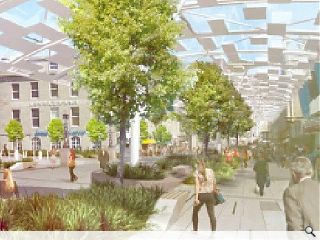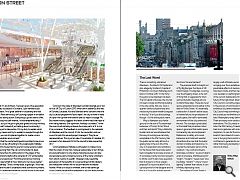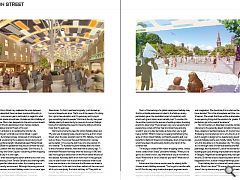Union Street
15 Apr 2014
Aberdeen’s Union Street may be in dire shape but one man thinks he has the solution to reverse the thoroughfare’s spiralling fortunes. Stepping into the void created by the city’s failed planning system John Halliday takes matters into his own hands with a lofty vision for a glazed ‘umbrella,’ but does it deliver? We give our verdict.
Aberdeen’s Union Street may celebrate the union between Britain and Ireland but there has been precious little unity in the city over more recent years, particularly in regard to what form its public spaces should take. Undeterred John Halliday of Halliday Fraser Munro has stepped into the acrimonious breach left by Sir Ian Wood’s abandoned Union Terrace Gardens scheme to table a Grands Projets of his own.Halliday’s ambition is to revitalise the Granite City by constructing an ‘umbrella over Union Street’, a giant dynamically illuminated canopy composed of a translucent covering that would bring the outdoors indoors along much of the thoroughfares length. Situated between Market Street and Bridge Street this pedestrian way would connect the city’s main railway station with four existing malls - Bon Accord, St Nicholas, Trinity and Union Square – becoming a fifth shopping centre for the city in its own right.
It would entail relocating the station entrance to a new civic square overlooking Union Terrace Gardens and diverting traffic through unspecified alternative routes, thus creating a more pedestrian friendly environment. Although the purely personal proposition remains uncosted Halliday insists it is no mere ‘pipe dream’ but is rather ‘practical and possible’ to achieve.
Speaking to Urban Realm Halliday said: “I’m not an Aberdonian, I’m from Loanhead originally, I just studied up here and stayed ever since. That’s one of the reasons I’m doing this, I got a free education and I’m genuinely just trying to give something back to people.” His time in the city has given Halliday plenty of opportunity to muse on its current failings, having first identified the need to move the station entrance more than 15 years ago.
Hammering home the need for action Halliday observed: “My wife was shopping today, she phoned me up from Union Street when the sales assistant said ‘oh Mrs Halliday, it’s awful wet out there. The sooner they put that bloomin’ canopy up the better.’ Of course she didn’t say who she was but it’s a no-brainer.” To illustrate his point Halliday likens his vision to that of another dreamer, more than half a century ago. “I remember President Kennedy when he stood up in 1961 and said ‘we’re going to land a man on the Moon before the end of this decade’. Kennedy didn’t know how much it was going to cost, he didn’t know how to build the rocket but what he did know was we have to do it because the Russians are ahead in the space race. So he said it and then walked out the room and left it up to everybody. And what did they do? They did it on the 21st July 1969. Just look at all the good things (such as non-stick pans) that have come from that.”
Shorn of the backing of a global superpower Halliday may find his umbrella pretensions limited to the fold-up variety, particularly given the inevitable torrent of scepticism with which such grand visions are invariably met. To counter this the architect points to the success of existing indoor shopping precincts, observing: “They’ve been very, very successful and people have voted with their feet and shop there and why wouldn’t you on a day like today up here when you’ve got heavy rainfall.” What’s more by increasing footfall along the spine of Union Street Halliday confidently predicts spill over benefits to Belmont Street and Castlegate, down at heal locales which have been hit particularly hard by the march of the covered mall.
“I’m trying to create a fifth indoor shopping centre, I stress indoor, called Union Street,” proclaims Halliday. “What you’ve got to do is have a vision, say what kind of city do we want to live in? What kind of Union Street do you want? What kind of inner city?”
Asked what the scheme would mean for already traffic choked streets Halliday answered: “You’ve got to handle traffic but it’ll find its way using creative transport engineers and a formal route will be devised. I don’t believe in bringing in road engineer’s right at the beginning, because it stumps all the flair and imagination. We should say this is what we the people have decided. This is the atmosphere we’d like; now you make it happen. We accept that there will be a downside elsewhere in reorganising things but the upside is far greater. Don’t let perfection get in the road of excellence.”
No commentary on Aberdeen would be complete without reference to the generally abject standard of development there, despite (or perhaps because of) its enormous oil wealth. Professing incomprehension as to why the city is struggling to pull its weight in design terms, despite being awash in petro-pounds Halliday said he was ‘totally, totally’ flummoxed as to why this should be so in his adopted city: “It’s a big puzzle, it’s not through a lack of individual abilities and flair. Is it the patronage, the mechanism? Look at the wonderful Victorian buildings put up by the big ship builders and tea planters in Glasgow. Magnificent buildings but they were patrons of the arts. Sir Ian has tried to become a patron and look what happened to him, it doesn’t help philanthropy does it?”
Does Halliday fear his scheme will vanish down the swanny just as Wood’s has done? “Of course I thought twice about it, it doesn’t do my business any good putting my head above the parapet, I’m just trying to encourage other people to do the same. It does actually take courage but I believed it was my duty to do it. I’m an architect, I’ve been given a free education I’ve been very successful in Scotland, I just wanted to put something back. I’m a great believer in citizenship and real democracy. Real democracy isn’t putting a paper in the ballot box, it’s about taking action. Everybody’s got an idea to offer.
“Everybody has self-interest, I love entrepreneurship, I lecture in it, but you’ve got to get past greed and stop thinking only of yourself. Instead of just talking about community I think you’ve got to take action. It’s my duty to explain what connectivity means and try to explain to people through the media how you can link places together to create a more pleasant pedestrian environment.”
Mindful that the contorted linguistics architects are prone to indulge in can be off putting to the wider public Halliday has enlisted his housemaid to give him some lessons in plain English, reasoning that if he can communicate his ideas intelligibly there then his call to action in the pages of the Press & Journal and before the cameras of STV will be better received and understood: “First thing tomorrow morning I’m going to spend half an hour talking to my house cleaner” observed Halliday. “She’s a lovely lassie, a good girl. She’s nae dumb, but she wouldn’t understand what connectivity means. She wouldn’t understand what the council would do and how the mechanisms would happen.”
Coming in the wake of Aberdeen’s embarrassingly poor bid to host UK City of Culture 2017, which saw it beaten by the likes of Dundee, Leicester, Hull and Swansea amid concerns that the city’s cultural programme ‘lacks depth’, the city is more in need of a pick-me-up than ever before (see our report on page 74). But recent history suggests this latest scheme has little hope of ever being realised. Ever optimistic Halliday countered: “I think the council will certainly embrace the major parts of it, to me it’s a no-brainer. The feedback is coming back to the residents of Aberdeen and the council, it’s for the councillors and our council to pick this up and project manage it. They’re our representatives. This is just an idea, it’s workable, it’s doable, it’s a present of an idea and it’s for the council to take ownership of it.”
Commendable as Halliday’s enthusiasm is it takes more than the vision of one man, however passionate, to turn things around; particular in a city where changing course is as slow and ponderous as turning around one of the many oil tankers from which it earns its wealth. Shoppers may need little persuasion of the benefits of a covered street whilst retailers and restaurant owners will no doubt welcome increased footfall. What is in doubt is whether, with a near bankrupt council, these people will be prepared to dip into their pockets to make this vision a reality.
THE LAST WORD
There is something odd about Aberdeen - Scotland’s Oil Capital and also, allegedly, Scotland’s Capital of Philistinism. As Owen Hatherley put it back in October 2011, “in the thirty-five years since Aberdeen has been The Oil Capital of Europe, the city has not seen a single worthwhile building in the city centre. Not one. Over a quarter-century of parsimony and mediocrity has been wealth’s bequest to the city.” It isn’t just the buildings though - it’s the entire public realm.
Why is Aberdeen such fertile ground for the sort of Fountainhead behaviour of Trump, Sir Ian Wood and their architects? Only a distinctly feudal mind-set would believe that this way of working was remotely acceptable in the 21st Century. Has the public sector really left such a gaping hole in the civic life of the city, in its aspirations and ambitions for the future that the private sector feels compelled to produce a series of ill-considered vanity toy-town projects to fill the void? It asks more questions than it answers. Is this a utopian proposal? Is it a provocation? Is it a cynical promo for the designer and his firm or is it a public spirited gesture – like Union Terrace Gardens?
The proposal itself is straight out of My Big Bumper Fun Book of UK Urban Design. The big idea, covering over the shopping street, is the sort of thing that is suggested for town centres at public meetings all over Scotland these days. These are never serious propositions and neither is this idea for Union Street - it’s essentially a distraction. It doesn’t tackle issues of market failure, the privatisation of public space, the traffic-dominated environment of the city centre and the rest. The concept is predicated on the belief that privatised indoor space is good and that public space is inherently risky and unpleasant. References to safety, anti-social behaviour and inclement weather all reinforce the view that the public domain is hostile and hazardous. To counter the nameless terrors of the outdoors – sky, roofs and towers, landscape, sunshine – we are invited to enter an anodyne, infantilised world - “bright”, “modern”, “supervised” and, inevitably, “vibrant” – where “mood lighting” is better than nature. It is an infinitely depressing vision.
The malaise of Union Street is largely a self-inflicted wound. Hand-wringing over the inevitable and predictable effects of decisions that have been made, and then repeated over decades is a defining feature of the current debate about the future of the high street. Aberdeen City Council is currently engaged in the process of commissioning an ambitious city centre masterplan. The City Council may be thinking big but this is rarely as worthwhile as thinking hard. Masterplans rarely deliver. There are many more constructive alternatives. The City needs to enter the 21st Century. It needs to treat iconic gestures with a dose of scepticism, to care for the incredible assets it has instead of covering them over or burying them and to have the confidence to generate its own ideas rather than being derailed by the daft notions of others.
Willie Miller
WMUD
|
|
Read next: Architectural Photography
Read previous: Cecil Balmond
Back to April 2014
Browse Features Archive
Search
News
For more news from the industry visit our News section.
Features & Reports
For more information from the industry visit our Features & Reports section.





